Pond Preparation for Pond Shield Epoxy
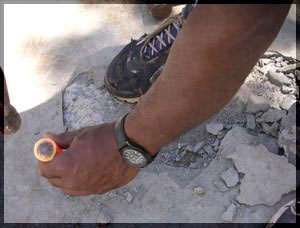 Pond Shield can be applied to both new water features and existing water features. In order for you to achieve the best results with your epoxy pond coating, you need to prepare the surface properly. Pond Shield epoxy coating was designed to adhere to many different surfaces including, cement, concrete, shotcrete, gunnite, cinder block, brick, stone, tile, wood, fiberglass, steel and aluminum. Simply put, the epoxy pond coatings can help you build a better pond!
Pond Shield can be applied to both new water features and existing water features. In order for you to achieve the best results with your epoxy pond coating, you need to prepare the surface properly. Pond Shield epoxy coating was designed to adhere to many different surfaces including, cement, concrete, shotcrete, gunnite, cinder block, brick, stone, tile, wood, fiberglass, steel and aluminum. Simply put, the epoxy pond coatings can help you build a better pond!
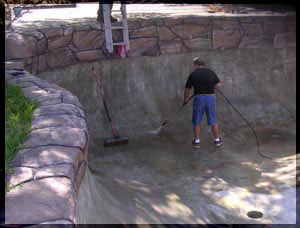 When preparing to apply your new epoxy pond coating, several things need to be considered, cleanliness, surface tooth and chemical properties of the surface area. Cleanliness can best be described as free of dirt or impurities. The example picture represents what can happen when a concrete render is not properly bonded to the concrete shell. This area, in specific, had a hollow spot beneath it and had to be chipped away and repaired before any epoxy pond coating could be applied.
When preparing to apply your new epoxy pond coating, several things need to be considered, cleanliness, surface tooth and chemical properties of the surface area. Cleanliness can best be described as free of dirt or impurities. The example picture represents what can happen when a concrete render is not properly bonded to the concrete shell. This area, in specific, had a hollow spot beneath it and had to be chipped away and repaired before any epoxy pond coating could be applied.
After any bad spots have been repaired, the chemical properties and surface tooth can be addressed. With concrete, cement and tile or stone types of materials, the surface area should be acid etched with muriatic acid. This will help slough off any of the powdery residue that forms when concrete cures. Most importantly it will neutralize the alkaline properties of the concrete (which is important for the proper bonding of your new epoxy pond coating).
Surfaces like wood, steel or aluminum, you'll need to abrade with a 60-grit sandpaper and clean before applying your epoxy pond coating.
Pond Shield Epoxy Application
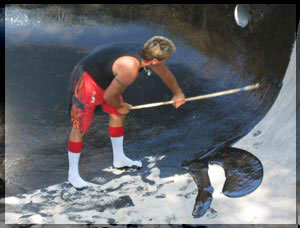 Applying Pond Shield couldn't be easier! If you've ever painted with a roller or a brush, then you know there's not much effort involved. The Pond Shield epoxy pond sealer has some major advantages over other sealers. For instance, Pond Shield has been designed thicker, meaning it will hang better on your pond walls. This means that your epoxy pond sealer will not sag or run, causing inconsistencies in the over-all thickness of your sealer. Once applied at 10 mils, the sealer will cure in that state. The epoxy sealer also comes in six standard colors and can even be ordered in custom colors!
Applying Pond Shield couldn't be easier! If you've ever painted with a roller or a brush, then you know there's not much effort involved. The Pond Shield epoxy pond sealer has some major advantages over other sealers. For instance, Pond Shield has been designed thicker, meaning it will hang better on your pond walls. This means that your epoxy pond sealer will not sag or run, causing inconsistencies in the over-all thickness of your sealer. Once applied at 10 mils, the sealer will cure in that state. The epoxy sealer also comes in six standard colors and can even be ordered in custom colors!
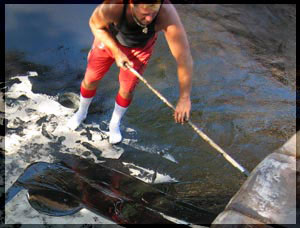 Pond Armor's exhaustive research has also revealed that not all ponds are created equal. Construction methods, pond age, and materials of different varieties all play a part in how each pond should be sealed. Not only was Pond Shield epoxy pond sealer created to be flexible in nature, but also flexible in regards to it's application. The Pond Shield epoxy pond sealer can be combined with other materials such as fiberglass mat or tape for added strength in cold joints or seams; or combined with colloidal silica filler as a thickening agent for larger than hairline cracks.
Pond Armor's exhaustive research has also revealed that not all ponds are created equal. Construction methods, pond age, and materials of different varieties all play a part in how each pond should be sealed. Not only was Pond Shield epoxy pond sealer created to be flexible in nature, but also flexible in regards to it's application. The Pond Shield epoxy pond sealer can be combined with other materials such as fiberglass mat or tape for added strength in cold joints or seams; or combined with colloidal silica filler as a thickening agent for larger than hairline cracks.
Start by mixing and pouring your epoxy pond sealer right into your pond. Use a rubber squeegee to spread the epoxy from one point to another and then a roller (on a extension handle if needed) to apply a smooth surface. Use the gauge sent with your order to check from time to time to make sure you are applying the sealer evenly at 10 mils throughout the process. Uneven or rough surfaces may use more material.
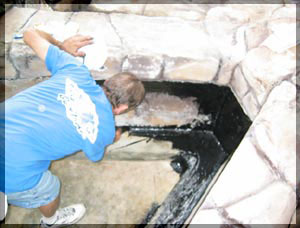 Be sure not to mix too much sealer at any given time to avoid waste in the event the material begins to harden before you finish. It's safe to say, you should mix what you know you can coat in under an hour. The pigmented versions of the epoxy pond sealer can be applied in one coat. After the sealer cures, which only takes about an hour, you can check for spots that may need to be touched up and do so at that time. Touching up your epoxy pond sealer within this time frame does not require any extra preparation to complete. It should be noted here that the epoxy should be abraded with 60-grit sandpaper only if more sealer is applied after a 24-hour period.
Be sure not to mix too much sealer at any given time to avoid waste in the event the material begins to harden before you finish. It's safe to say, you should mix what you know you can coat in under an hour. The pigmented versions of the epoxy pond sealer can be applied in one coat. After the sealer cures, which only takes about an hour, you can check for spots that may need to be touched up and do so at that time. Touching up your epoxy pond sealer within this time frame does not require any extra preparation to complete. It should be noted here that the epoxy should be abraded with 60-grit sandpaper only if more sealer is applied after a 24-hour period.
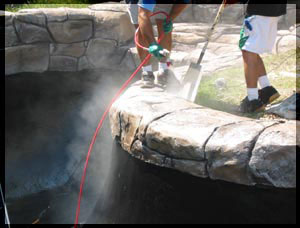 You can use a paint brush to cut in the epoxy sealer where a paint roller is not practical. You can also use a plastic squeegee to move it as well. Just keep the required thickness in mind as you do. The Pond Shield epoxy pond sealers can also be sprayed. Pond Shield epoxy sealers require specific settings in order to be used with air spray systems and airless spray systems. For more information regarding these settings, please read the page on Spraying Pond Shield Epoxy.
You can use a paint brush to cut in the epoxy sealer where a paint roller is not practical. You can also use a plastic squeegee to move it as well. Just keep the required thickness in mind as you do. The Pond Shield epoxy pond sealers can also be sprayed. Pond Shield epoxy sealers require specific settings in order to be used with air spray systems and airless spray systems. For more information regarding these settings, please read the page on Spraying Pond Shield Epoxy.
Note: you should always use proper protective clothing and take proper safety precautions for any installation.
This product was added to our catalog on Thursday 09 April, 2009.
